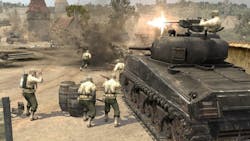Researchers eye embedding artificial intelligence (AI) into war games simulation to beef-up challenges
ARLINGTON, Va. – U.S. military researchers are asking industry to develop artificial intelligence (AI) algorithms to simulate challenging enemy behavior during war games that reacts in ways not easily replicated by human role-players.
Officials of the U.S. Defense Advanced Research Projects Agency (DARPA) in Arlington, Va., issued a solicitation last week (DARPA-PA-19-03-08) for the COnstructive Machine-learning Battles with Adversary Tactics (COMBAT) project.
COMBAT will develop artificial intelligence (AI) algorithms to generate models of enemy brigade behaviors that challenge and adapt to friendly forces in simulation experiments.
The project seeks to model how an adversary may evolve from current to future tactics based on friendly force actions and responses. The idea is to develop several feasible enemy courses of action rapidly, identify optimal solutions, and provide reasoning to support recommendations.
In future war games, COMBAT will deliver an artificially intelligent enemy that can challenge friendly force participants and stimulate development of new battle tactics.
Army war games today use enemy operators who rely on long-established tactics against their friendly opponents. COMBAT seeks to disrupt traditional enemy strategy by generating surprising new enemy actions using AI.
This will challenge the preconceptions and require new friendly force tactics. Emerging AI techniques never have been applied to this before.
Companies selected will model enemy motorized rifle brigade tactics in a force-on-force modeling and simulation tool of the performer’s choosing. This tool must be able to model several company-size enemy forces in a brigade; their command-and-control hierarchies; and behaviors at the brigade, operational, and tactical levels.
Modeling entities at the company-level reduces the effect of terrain on individual units, while still displaying representative capabilities.
Companies selected will develop their initial enemy AI algorithms and behaviors according to “The Russian Way of War: Force Structure, Tactics and Modernization of Russian Ground Forces,” published by the Army Foreign Military Studies Office, 2016.
Companies interested should upload responses to the DARPA BAA Website no later than 26 June 2020 at https://baa.darpa.mil.
Email questions or concerns to DARPA's Paul Zablocky, the COMBAT program manager, at [email protected]. More information is online at https://beta.sam.gov/opp/cee2af5112e84688b94a5b3de159048c/view.
About the Author
John Keller
Editor-in-Chief
John Keller is the Editor-in-Chief, Military & Aerospace Electronics Magazine--provides extensive coverage and analysis of enabling electronics and optoelectronic technologies in military, space and commercial aviation applications. John has been a member of the Military & Aerospace Electronics staff since 1989 and chief editor since 1995.
